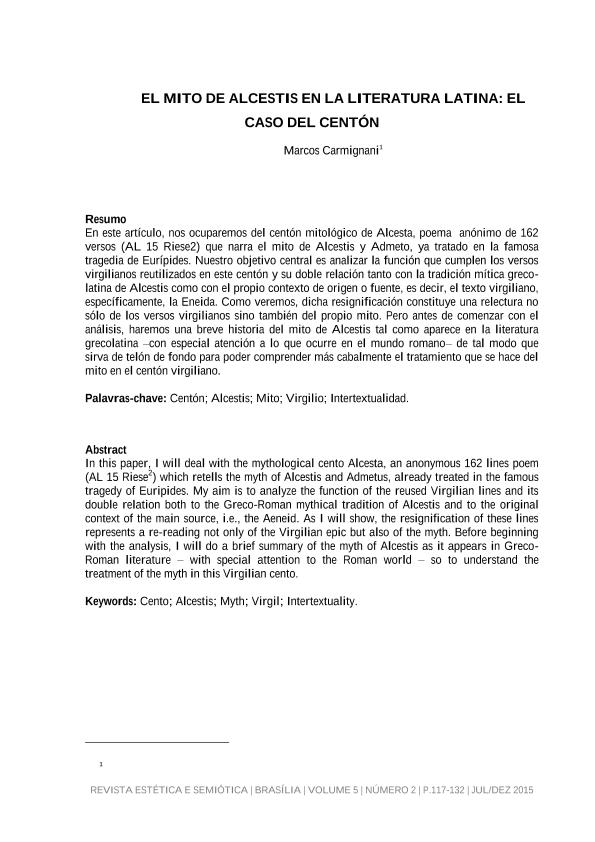Artículo
En este artículo, nos ocuparemos del centón mitológico de Alcesta, poema anónimo de 162 versos (AL 15 Riese2) que narra el mito de Alcestis y Admeto, ya tratado en la famosa tragedia de Eurípides. Nuestro objetivo central es analizar la función que cumplen los versos virgilianos reutilizados en este centón y su doble relación tanto con la tradición mítica grecolatina de Alcestis como con el propio contexto de origen o fuente, es decir, el texto virgiliano, específicamente, la Eneida. Como veremos, dicha resignificación constituye una relectura no sólo de los versos virgilianos sino también del propio mito. Pero antes de comenzar con el análisis, haremos una breve historia del mito de Alcestis tal como aparece en la literatura grecolatina –con especial atención a lo que ocurre en el mundo romano– de tal modo que sirva de telón de fondo para poder comprender más cabalmente el tratamiento que se hace del mito en el centón virgiliano. In this paper, I will deal with the mythological cento Alcesta, an anonymous 162 lines poem (AL 15 Riese2 ) which retells the myth of Alcestis and Admetus, already treated in the famous tragedy of Euripides. My aim is to analyze the function of the reused Virgilian lines and its double relation both to the Greco-Roman mythical tradition of Alcestis and to the original context of the main source, i.e., the Aeneid. As I will show, the resignification of these lines represents a re-reading not only of the Virgilian epic but also of the myth. Before beginning with the analysis, I will do a brief summary of the myth of Alcestis as it appears in GrecoRoman literature – with special attention to the Roman world – so to understand the treatment of the myth in this Virgilian cento.
El mito de Alcestis en la literatura latina: el caso del Centón
Fecha de publicación:
12/2015
Editorial:
Universidade de Brasília. Faculdade de Arquitetura e Urbanismo
Revista:
Revista de Estética e Semiótica
ISSN:
2238-362X
Idioma:
Español
Tipo de recurso:
Artículo publicado
Clasificación temática:
Resumen
Palabras clave:
Centon
,
Alcesta
,
Literatura Latina
Archivos asociados
Licencia
Identificadores
Colecciones
Articulos(CIECS)
Articulos de CENTRO DE INVESTIGACIONES Y ESTUDIO SOBRE CULTURA Y SOCIEDAD
Articulos de CENTRO DE INVESTIGACIONES Y ESTUDIO SOBRE CULTURA Y SOCIEDAD
Citación
Carmignani, Marcos Flavio; El mito de Alcestis en la literatura latina: el caso del Centón; Universidade de Brasília. Faculdade de Arquitetura e Urbanismo; Revista de Estética e Semiótica; 5; 2; 12-2015; 117-132
Compartir




